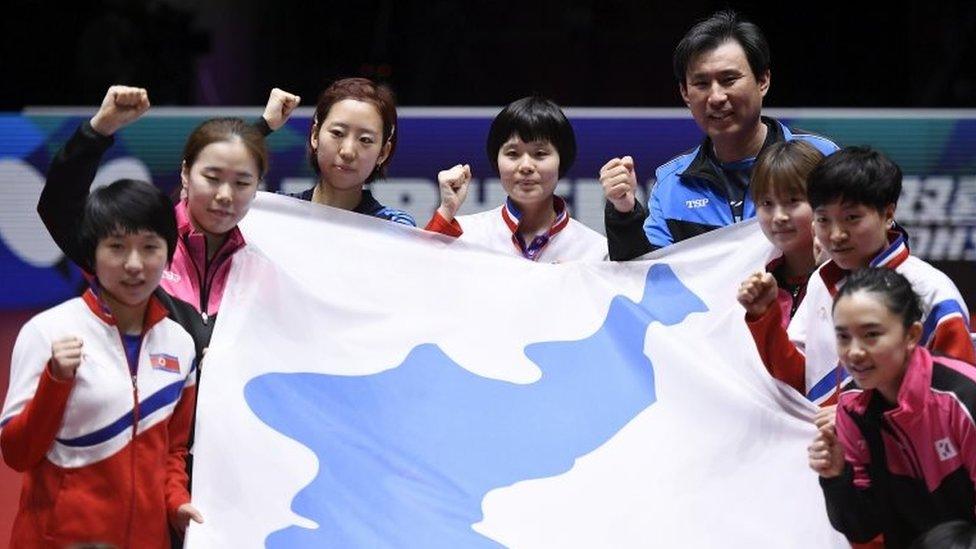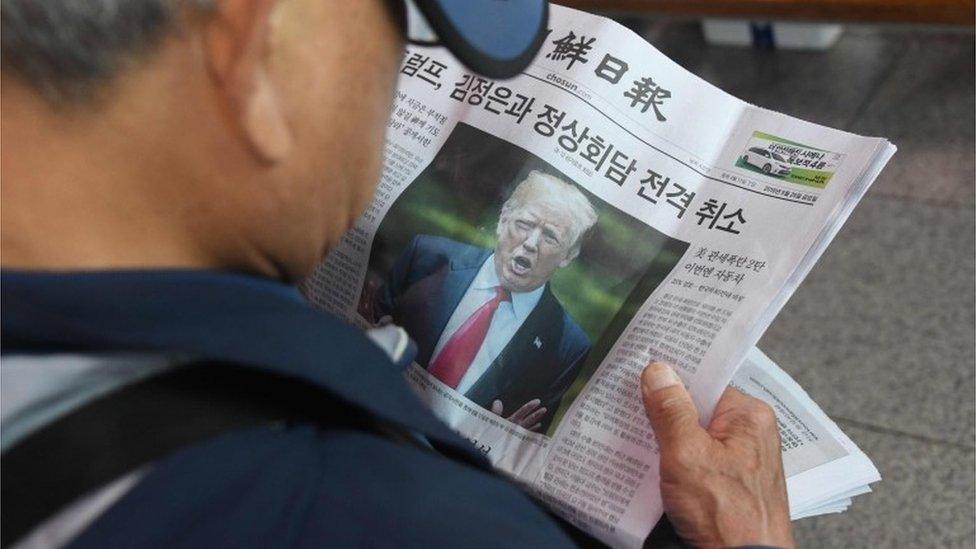North Korea's Kim Jong-un 'set on Trump summit'
- Published
Korean leaders' surprise "Hollywood" meeting
It is North Korean leader Kim Jong-un's "fixed will" that a summit with US President Donald Trump in Singapore should go ahead, state media say.
This followed a surprise meeting on Saturday between Mr Kim and South Korean President Moon Jae-in.
Mr Trump had cancelled the 12 June summit citing North Korea's "hostility" - but on Saturday he said things were "moving along very nicely".
Meanwhile US officials are reported to have travelled to the North on Sunday.
The American team, led by Sung Kim, a former ambassador to South Korea, was due to hold talks with North Korean Vice-Foreign Minister Choe Son-hui on preparations for the summit, US and South Korean media say.
The meeting would be the culmination of diplomatic efforts that began this year to try to defuse what had threatened to become a military confrontation between the nuclear-armed communist North and the South and its US ally.
What came out of Saturday's surprise talks?
The North's KCNA agency released a detailed statement on the meeting and the South Korean president also delivered remarks. It was the leaders' second meeting in as many months.
Mr Moon said he and Mr Kim had "agreed that the 12 June summit should be held successfully" and that the North Korean leader had "again made clear his commitment to a complete denuclearisation of the Korean peninsula".
But Mr Moon suggested Mr Kim was not certain whether Washington could guarantee the stability of his regime.
"What Kim is unclear about is that he has concerns about whether his country can surely trust the United States over its promise to end hostile relations," Mr Moon said.
The KCNA statement said the two leaders had had a "candid dialogue" and that Mr Kim had "expressed his fixed will on the historic... summit talks". He had called for co-operation to "establish a mechanism for permanent and durable peace" and the opening of a "new era of reconciliation and unity".
It added that "top leaders" from the two nations would hold more talks on Friday.
What did Mr Trump say?
At the White House late on Saturday he said: "It's moving along very nicely. We're looking at June 12 in Singapore. That hasn't changed."
He also took to Twitter to angrily dismiss media speculation that the summit, even if reinstated, could not now be held in Singapore in the existing time frame:
Mr Trump said the denuclearisation of the Korean peninsula would be "great for the world"
The White House confirmed that an advance team of officials would leave for Singapore this weekend, as originally scheduled, to prepare for the possible summit.
Allow X content?
This article contains content provided by X. We ask for your permission before anything is loaded, as they may be using cookies and other technologies. You may want to read X’s cookie policy, external and privacy policy, external before accepting. To view this content choose ‘accept and continue’.
Mr Trump had declared the summit cancelled on Thursday, blaming North Korea's "tremendous anger and open hostility", but then tweeted on Friday that "very productive talks" had taken place with the North.

The long-dreamed-of prize
Analysis by the BBC's Rupert Wingfield-Hayes in Seoul
The pictures from the second summit between Kim Jong-un and Moon Jae-in show how dramatically the atmosphere has changed here on the peninsula.
Their first summit in April took months to arrange. On Saturday, they met just 24 hours after a phone call from Pyongyang.
It is significant that this second meeting was requested by Mr Kim. It is clear he really wants to salvage the Singapore summit. The question that remains is why?
President Trump's supporters think Mr Kim is now desperate to find a way out of crushing economic sanctions. But the rhetoric from Pyongyang suggests Kim Jong-un believes his nuclear arsenal puts him in a much stronger position than his father or grandfather and, because of that, he is very close to grasping the long-dreamed-of prize, a face-to-face summit with a US president.

What needs to be sorted ahead of the summit?
As Mr Moon alluded to, there is still a lot of ground to be covered and Mr Trump has clearly shown that if does not think a deal can be done, he will not go.
Mr Moon said after Saturday's meeting that although the US and North Korea "share the same resolve, there need to be discussions regarding the roadmap for how to make it happen, and that process could be tough"
The nuclear word Trump and Kim can't agree on
Mr Moon himself has declined to define what "complete denuclearisation" means and it is unclear whether Mr Kim will agree to fully abandon his nuclear arsenal. Similar pledges in the past have not been upheld.
Analysts say the US had wanted denuclearisation first - followed by rewards in the form of lifted sanctions and economic aid.
Mr Kim has indicated he wants a phased approach, with his steps met by reciprocal ones from the US and the South - mainly on sanctions but also easing of the US military presence in South Korea.
Mr Trump has not ruled out such an incremental approach.
North Korea has been subjected to numerous rounds of international sanctions since 2006, which has cut off most of its exports and capped its imports of oil.
The North also wants assurances that its survival as a state would never be in question.
How did we get here?
Getting this far has been a surprise given that North Korea had maintained its strident rhetoric - and continued its nuclear and missile tests - through 2016 and 2017.
This brought a bitter war of words between Mr Trump and the North Korean leadership.
But a rapprochement began in January when Mr Kim suggested he was "open to dialogue" with South Korea.

Koreans played under a unified flag at the Winter Olympics
The following month the two countries marched under one flag at the opening ceremony of the Winter Olympics, held in the South.
Mr Kim announced he was suspending nuclear tests and held his landmark summit with Mr Moon last month, where the pair agreed to work to rid the peninsula of nuclear weapons.
This week North Korea said it had dismantled its Punggye-ri nuclear test site, although scientists believe it partially collapsed after the last test in September 2017, rendering it unusable.
- Published24 May 2018
- Published25 May 2018

- Published5 September 2023

- Published21 April 2020
